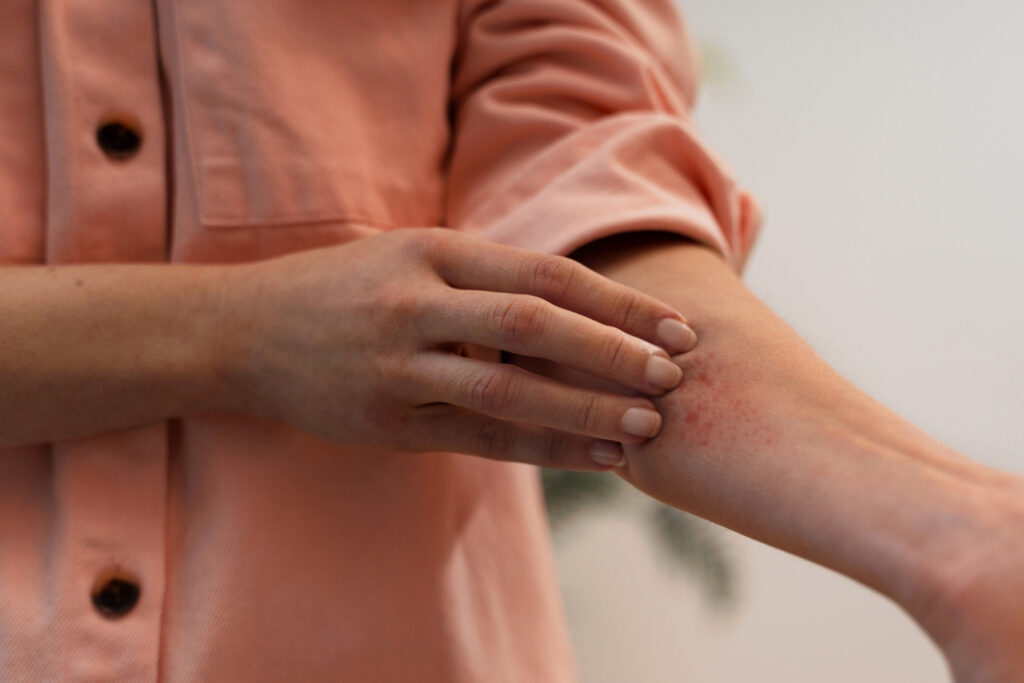Lupus is a chronic autoimmune disease that causes pain and inflammation throughout the body. When most people refer to “lupus,” they are talking about systemic lupus erythematosus (SLE), the most common form.
In a healthy immune system, the body defends against infections. However, in lupus, the immune system mistakenly attacks the body’s own tissues, leading to tissue damage and illness.
Lupus Symptoms
Symptoms of lupus can vary widely between individuals. Some common symptoms include:
- Achy joints (arthralgia)
- Fever higher than 100°F
- Swollen joints (arthritis)
- Persistent fatigue
- Skin rash
- Ankle swelling
- Chest pain with deep breaths (pleurisy)
- Butterfly-shaped rash on the face (malar rash)
- Hair loss
- Sensitivity to sunlight
- Seizures
- Mouth or nose sores
- Raynaud’s phenomenon (pale or purple fingers/toes in cold or stress)
Early Symptoms
Early signs of lupus can include fever, weakness, weight loss, and joint pain. The characteristic butterfly rash on the face is a notable sign that often appears after sun exposure.
Lupus Causes
The exact cause of lupus is unknown, but a combination of genetic, hormonal, and environmental factors is believed to trigger the immune system’s malfunction. Potential triggers include:
- Genes: Certain ethnicities are more prone to lupus, suggesting a genetic component.
- Hormones: Higher estrogen levels in women, especially before menstruation and during pregnancy, may increase lupus risk.
- Environment: Factors such as cigarette smoke, silica, mercury, certain viruses, UV light, and stress can contribute to lupus onset.
- Medications: Some drugs can induce lupus, which typically resolves after stopping the medication.
Risk Factors
Lupus is more common among:
- Women (90% of cases)
- People aged 15-45 years
- Those with a family history of lupus
- Certain ethnic groups, including African American, Asian, Hispanic, and Native American populations
Types of Lupus
- Systemic Lupus Erythematosus (SLE): Affects multiple organs and systems.
- Lupus Nephritis: Inflammation of the kidneys due to SLE.
- Cutaneous Lupus: Affects the skin with various types of rashes and lesions.
- Discoid Lupus: Chronic cutaneous lupus causing red, scaly patches, often leading to scarring.
- Drug-induced Lupus: Triggered by certain medications, resolving after discontinuation.
- Neonatal Lupus: Occurs in infants of mothers with SLE.
Diagnosis
Diagnosis involves a combination of symptom evaluation, physical exams, and lab tests. Key signs include the butterfly rash, discoid rash, photosensitivity, oral ulcers, arthritis, and organ inflammation. Blood tests for ANA, anti-SM, and anti-DNA antibodies are crucial.
Treatment
Treatment depends on the severity and specific symptoms. Common medications include:
- Biologics: Belimumab (Benlysta), Rituximab (Rituxan)
- Immunosuppressants: Anifrolumab-fnia, Azathioprine, Mycophenolate mofetil
- Corticosteroids: Topical creams, oral steroids (prednisone)
- NSAIDs: Ibuprofen, naproxen
- Antimalarials: Hydroxychloroquine (Plaquenil)
- Chemotherapy Drugs: Cyclophosphamide (Cytoxan), Methotrexate (Rheumatrex)
Alternative Treatments
Some complementary treatments may help alleviate symptoms, including:
- Vitamins and supplements (Vitamin C, D, antioxidants)
- Fish oil (omega-3 fatty acids)
- DHEA hormone
- Acupuncture
- Mind-body therapy
Living With Lupus
Adopting a healthy lifestyle can ease lupus symptoms:
- Exercise regularly (low-impact activities)
- Get sufficient rest
- Eat a balanced diet
- Avoid alcohol and smoking
- Protect against sun exposure
- Manage fevers promptly
- Stay informed and involved in your care
Support for Those Living With Someone Who Has Lupus
- Educate yourself about lupus
- Be supportive but respect personal space
- Attend doctor visits if possible
- Encourage self-care and adherence to treatment
- Communicate openly about fears and needs
Conclusion
Lupus is an autoimmune disease characterized by flares and remission. While there is no cure, ongoing research continues to improve treatments and quality of life for those affected. A healthy lifestyle, informed care, and support systems are crucial in managing lupus.
